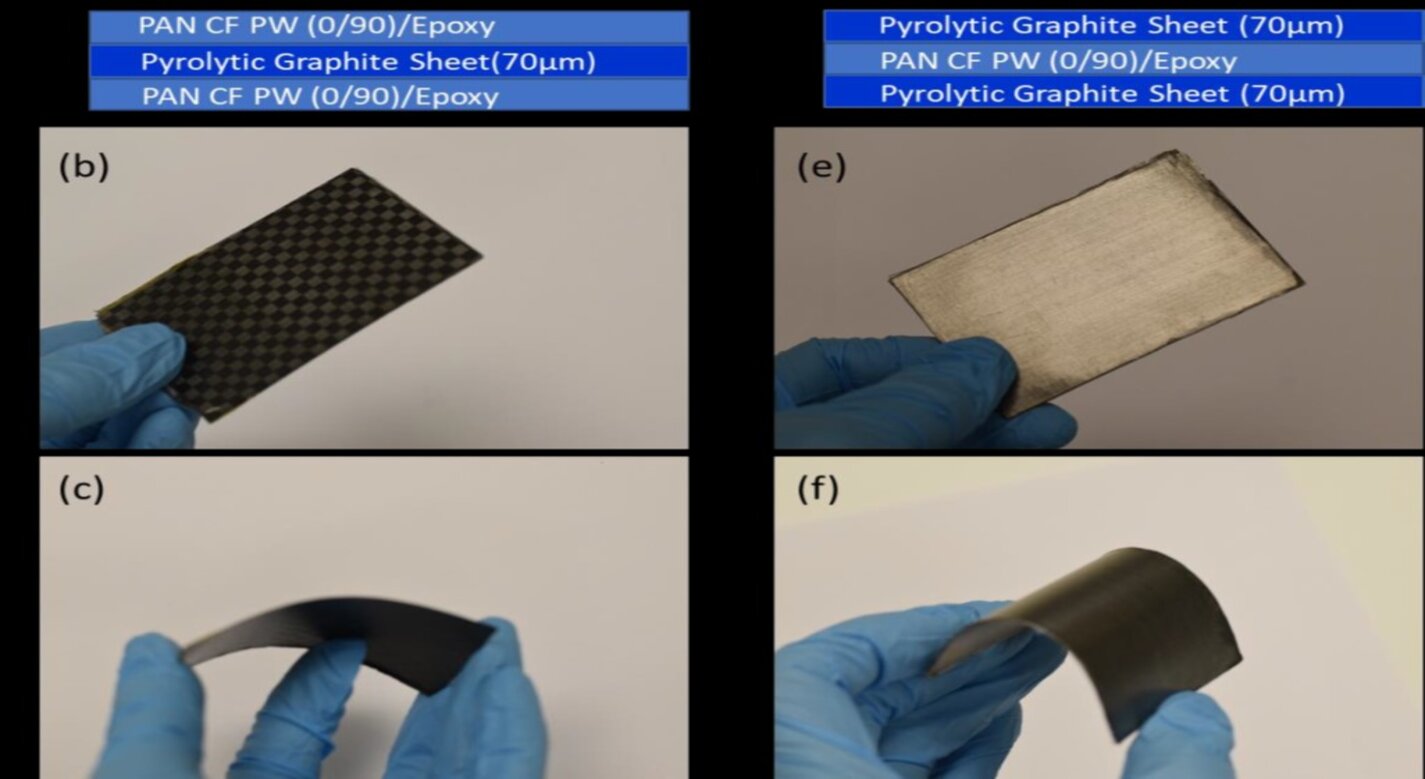Conductive Carbon Fiber Polymer Composite
materials and coatings
Conductive Carbon Fiber Polymer Composite (LAR-TOPS-370)
The Light Weight and Strength of Carbon Fiber Composite with the Thermal Conductivity of Metal Alloys
Overview
A team of inventors from NASA Langley and NASA Ames have created a new type of carbon fiber polymer composite that has a high thermal conductivity. This was achieved by incorporating Pyrolytic Graphite Sheets (PGSs) and Carbon Nanotubes (CNTs), which enhance the material's ability to transfer heat when compared to typical carbon fiber composites.
Carbon fiber polymer composites are frequently used in aerospace structures because they are light, strong, and require minimal maintenance. However, they typically have poor thermal conductivity, which limits their use to applications where heat transfer is not required. Where heat transfer is needed, aluminum alloys are used instead, but they have drawbacks such as lower strength, higher weight, and increased maintenance needs compared to composites.
The new material developed by NASA addresses this issue by combining the benefits of a carbon fiber composite with the high thermal conductivity of metal alloys. NASA is currently working on using this material for in-space applications, such as heat exchangers or radiators for removing carbon dioxide from the crew cabin atmosphere. On Earth, the composite could be used to create new radiators or heat exchangers for use in automotive or electronics applications.
The Technology
The new composite developed by NASA incorporates PGS and CNTs to enhance its thermal conductivity while preserving the mechanical properties of the underlying carbon fiber polymer composite. NASA has also improved the composite manufacturing process to ensure better thermal conductivity not only on the surface, but also through the thickness of the material. This was achieved by adding perforations that enable the additives to spread through the composite.
The process for developing this innovative, highly thermally conductive hybrid carbon fiber polymer composite involves several steps. Firstly, a CNT-doped polymer resin is prepared to improve the matrix's thermal conductivity, which is then infused into a carbon fiber fabric. Secondly, PGS is treated to enhance its mechanical interface with the composite. Thirdly, perforation is done on the pyrolytic graphite sheet to improve the thermal conductivity through the thickness of the material by allowing CNT-doped resin to flow and better interlaminar mechanical strength. Finally, the layup of PGS and CNT-CF polymer is optimized.
Initial testing of the composite has shown significant increases in thermal conductivity compared to typical carbon fiber composites, with a more than tenfold increase. The composite also has higher thermal conductivity than aluminum alloys, with more than twice the thermal conductivity of the Aluminum 6061 typically used in the aerospace industry. For this new material, NASA has completed a proof-of-concept demonstration and work continues to use the material in a heat exchanger system and further characterize the properties including longevity and radiation impact analysis.


Benefits
- High In-Plane Thermal Conductivity: compared to state-of-the-art materials like carbon fiber composites (over 10 times) and aluminum alloys used in space structures and heat exchangers (2 times higher)
- Improved Through-Thickness Thermal Conductivity: adding perforations improves thermal conductivity not just on the surface but also through the thickness of the material.
- Reduced Weight: replacing some aluminum with composites lightens the weight of components like heat exchangers.
- Reduced Heat-Induced Damage or Shape Distortions: this conductive composite can wick heat away from hot surfaces to avoid heat build up leading to damage and distortion.
Applications
- Aerospace Thermal Management: highly efficient heat exchangers and radiators that are lightweight, durable, and have excellent thermal performance high performance
- Aerospace Structures: as payload booms and solar cell arrays for in-space use
- Aerospace CO2 Removal: improved thermal conductivity of the composite would allow for more efficient removal of CO2 from the atmosphere of crew spaces, reducing the risk of harmful buildup.
- Automotive and Electronics: composite could be used to develop new radiators and heat exchangers for electric vehicles.
Technology Details
materials and coatings
LAR-TOPS-370
LAR-20254-1
Jin Ho Kang and Keith L. Gordon, et. al. Highly Thermally Conductive Hybrid Carbon Fiber Polymer Composite for Radiator Application.52nd International Conference on Environmental Systems, 16-20 July 2023, Calgary, Canada.
|
Tags:
|
Similar Results

Conductive Polymer/Carbon Nanotube Structural Materials and Methods for Making Same
Carbon nanotubes (CNTs) show promise for multifunctional materials for a range of applications due to their outstanding combination of mechanical, electrical and thermal properties. However, these promising mechanical properties have not translated well to CNT nanocomposites fabricated by conventional methods due to the weak load transfer between tubes or tube bundles.
In this invention, the carbon nanotube forms such as sheets and yarns were modified by in-situ polymerization with polyaniline, a -conjugated conductive polymer. The resulting CNT nanocomposites were subsequently post-processed to improve mechanical properties by hot pressing and carbonization. A significant improvement of mechanical properties of the polyaniline/carbon nanotube nanocomposites was achieved through a combination of stretching, polymerization, hot pressing, and carbonization.

Highly Thermal Conductive Polymeric Composites
There has been much interest in developing polymeric nanocomposites with ultrahigh thermal conductivities, such as with exfoliated graphite or with carbon nanotubes. These materials exhibit thermal conductivity of 3,000 W/mK measured experimentally and up to 6,600 W/mK predicted from theoretical calculations. However, when added to polymers, the expected thermal conductivity enhancement is not realized due to poor interfacial thermal transfer.
This technology is a method of forming carbon-based fillers to be incorporated into highly thermal conductive nanocomposite materials. Formation methods include treatment of an expanded graphite with an alcohol/water mixture followed by further exfoliation of the graphite to form extremely thin carbon nanosheets that are on the order of between about 2 and about 10 nanometers in thickness. The carbon nanosheets can be functionalized and incorporated as fillers in polymer nanocomposites with extremely high thermal conductivities.

Advanced Materials for Electronics Insulation
Many researchers have attempted to use polymer-ceramic composites to improve the thermal and dielectric performance of polymer insulation for high voltage, high temperature electronics. However, using composite materials has been challenging due to manufacturing issues like incomplete mixing, inhomogeneous properties, and void formation. Here, NASA has developed a method of preparing and extruding polymer-ceramic composites that results in high-quality, flexible composite ribbons.
To achieve this, pellets of a thermoplastic (e.g., polyphenylsulfone or PPSU) are coated with an additive then mixed with particles of a ceramic (e.g., boron nitride or BN) as shown in the image below. After mixing the coated polymer with the ceramic particles, the blended material was processed into ribbons or films by twin-screw extrusion. The resulting ribbons are highly flexible, well-mixed, and void free, enabled by the coated additive and by using a particle mixture of micronized BN and nanoparticles of hexagonal BN (hBN).
The polymer-ceramic composite showed tunable dielectric and thermal properties depending on the exact processing method and composite makeup. Compared to the base polymer material, the composite ribbons showed comparable or improved dielectric properties and enhanced thermal conductivity, allowing the composite to be used as electrical insulation in high-power, high-temperature conditions.
The related patent is now available to license. Please note that NASA does not manufacturer products itself for commercial sale.

Dispersion of Carbon Nanotubes in Polymers
The technology portfolio spans several methods for dispersion and processing of CNTs in polymer resins and composites. CNT/resin systems with high dispersion and long-term stability are provided by three general approaches. One method relies on mechanical dispersion by sonication simultaneous with partial polymerization to increase the resin viscosity to maintain dispersion and enable further polymer processing of the CNT blend into films and other articles. Another approach relies on what is termed donor acceptor bonding, which essentially is a dipole bond created on the CNT/resin interface to maintain dispersion and stability of the CNT/resin blend. This dispersion method also provides advantages in mechanical properties of processed composites due to the interface characteristics. A range of polymer types can be used, including polymethyl methacrylate, polyimide, polyethylene, and others.
An additional dry blending approach provides advantages for a variety of
thermoplastic and thermoset systems. Use of ball mill mixing achieves effective
blending and dispersion of the CNT, even at high loadings. Further processing steps
using injection molding or similar melt processing methods have yielded CNT/
polymer composites with a range of useful electronic, optical, and mechanical
properties.

A New Class of Strong and Flexible Carbon Fiber Reinforced Phenolic Composites
This unique approach modifies the phenolic polymer network by adding thermoplastic molecules with flexible segments such as aliphatic carbon and siloxane. The thermoplastic molecules are terminated with bifunctional groups that can directly react with the phenolic under the curing condition to form chemical bonds. Further incorporation of these segments can be facilitated by a relay reaction of a second molecular component which can bond with both the first flexible segments and the phenolic network. The selections of flexible, thermoplastic segments are based on desired properties, which include flexibility, ablative, an charring ability, heat resistance, and low catalycity.
The modified phenolic is a truly molecular composite in which flexible segments are connected with the phenolic network through strong chemical bonds and are uniformly distributed among the networks. This feature renders a uniform toughening/strengthening effect without compromising the lightweight nature of the materials. The process is also feasible to scale up and amenable for manufacturing.



